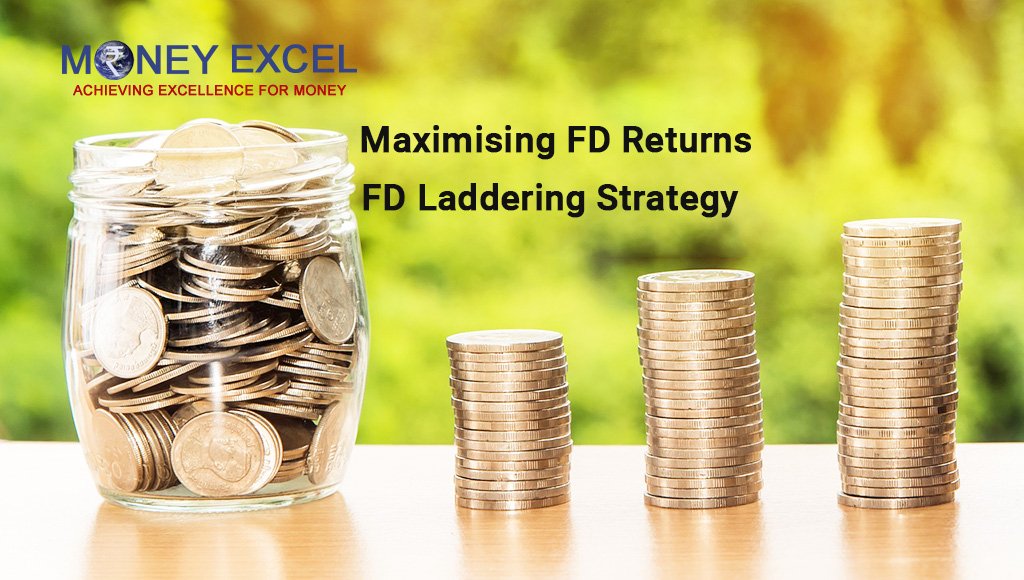In its Monetary Policy Committee (MPC) meeting, the Reserve Bank of India (RBI) decided to hold the repo rate. This decision was followed by six consecutive rises in the repo rate. For conservative investors, this meant good news, as fixed deposits (FDs) rates on offer right now are quite high.
So, as one of the best investment safe instruments, opening a fixed deposit account now is better than ever. This is true whether you decide to invest for the short or long term, as the interest earnings at the current rates will be significant.
Generally, issuers offer higher FD interest rates on accounts with long-term tenors. However, if you do not wish to invest your money for several years, you can maximise your FD returns by opting for the laddering approach.
Read on to know more about how you can maximise your FD returns through FD laddering in the current rate regime.

What is the FD Laddering Strategy?
With the RBI’s decision to keep the repo rate unchanged, experts believe that the central bank will not increase the repo rate further. If the current rates prevail or they are reduced, FD laddering strategy can benefit you in maximising your returns.
As per this strategy, you are to park your money in multiple fixed deposit accounts with each of them having different tenors. This not only allows you to align your returns with the prevailing FD interest rates but also minimises the risk by diversifying your investment.
However, you also get to enjoy higher liquidity as some amount will always be available for reinvestment. For instance, if you have an investing corpus of ₹10 Lakhs, you have several options to invest when choosing to ladder it with FDs.
Here, you can either split it into 5 FDs with the same issuer, each of ₹2 Lakh, spread across tenors from 1 to 5 years. This way, you enjoy returns on an investment of ₹2 Lakh each year, while investing the whole sum.
Another option would be to invest your corpus of ₹10 Lakh based on your goals. For instance, if you need to make a large expense of ₹7 Lakh in 5 years, you could invest ₹5 Lakh for 5 years in an instrument with an interest rate of 7.6% p.a.
You can then split the remaining ₹5 Lakh into two FDs worth ₹2.5 Lakh each, with different tenors. This would result in returns of ₹7 Lakhs in 5 years from your first FD, along with staggered returns from your short-term FDs in the same window.
Considering the current repo rate pause, laddering allows you to take advantage of the current rates completely. This is because you can lock-in your funds, based on your goals, and invest efficiently.
Benefits of FD Laddering Strategy
The following are some of the benefits you get to enjoy when you adopt the FD laddering approach toward investment:
- Diversification: Splitting your investment and parking it into different fixed deposit accounts allow you to leverage high rates from leading issuers.
- Higher Liquidity: The FD laddering strategy offers a higher level of liquidity than a long-term FD. With this strategy, some amount will always be available for reinvestment at prevailing FD interest rates.
- Higher Returns: In comparison to a long-term FD, having multiple FD accounts have the potential to earn higher returns
- Best Rates: With FD laddering strategy, you can assess FD interest rates offered by different issuers and invest where you get the best rates
- Flexible: This strategy also offers high flexibility as you can adjust your investment strategy as per your goals
- Tax Benefits: Adopting this strategy also optimises the tax outflow by managing tax liabilities
- Simple Approach: FD laddering is a simple strategy that can also be implemented by the beginner investors
How To Maximise Returns Through FD Laddering Strategy
Now that you have understood the benefits of FD laddering, here is how you can maximise your FD returns with an example.
Consider that you have ₹2 Lakhs to invest in FDs. You can invest ₹40,000 in five different FDs across different tenors. Here, you need to choose issuers that offer high FD interest rates for the tenor.
Your FD investment portfolio will look something like these if you adopt this strategy:
| Financial Institution | Tenor | Investment Amount | Interest Rates |
| Issuer A | 6 months | ₹40,000 | 8.75% |
| Issuer B | 1 Year | ₹40,000 | 8% |
| Issuer B | 2 Years | ₹40,000 | 7.90% |
| Issuer C | 3 Years | ₹40,000 | 8.50% |
| Issuer D | 5 Years | ₹40,000 | 7.85% |
By following this strategy, you will always have some amount to reinvest on the prevailing FD interest rates. Do note that you can also open multiple FD accounts with the same issuer. This is often the simpler route to take, as you don’t have to comply with different terms each time you want to invest.
However, choosing different issuers has its upsides because of the rates offered. The rates you get will vary based on the tenor, with some issuers offering a higher rate than others. As such, the right option is to pick issuers that offer you the highest returns.
In conclusion, the RBI kept the repo rate on hold in the previous Monetary Policy Committee (MPC) meeting. Many experts believe that this is an indication that the Central Bank may lower the rates further in the near future.
Naturally, this means you should invest now and make the most of the current offers. Here, an efficient way to invest your money is by choosing the FD and by adopting the laddering strategy. It best leverages the current FD interest rates at varying tenors while granting you liquidity all through.

